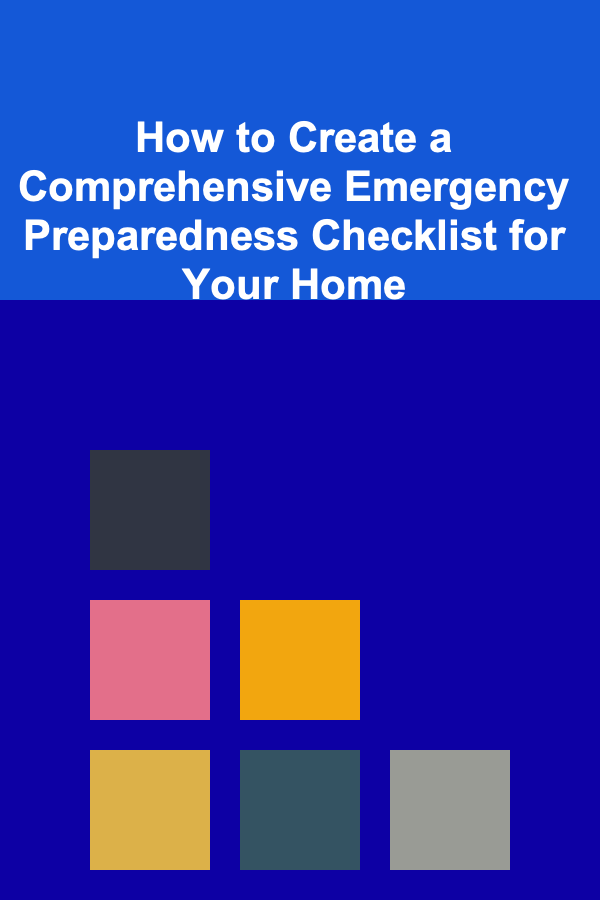
How to Create a Comprehensive Emergency Preparedness Checklist for Your Home
ebook include PDF & Audio bundle (Micro Guide)
$12.99$10.99
Limited Time Offer! Order within the next:

Emergencies can strike at any time, and when they do, being prepared can make all the difference. Whether it's a natural disaster, power outage, medical emergency, or other unexpected events, having a clear and actionable plan can save lives and minimize the impact. One of the most important components of emergency preparedness is creating a comprehensive emergency checklist for your home.
An emergency preparedness checklist serves as a roadmap for what you and your family should do before, during, and after a disaster or crisis. It not only helps you stay organized, but it also provides peace of mind knowing you're ready for any unforeseen situation. In this guide, we'll walk you through how to create a thorough emergency preparedness checklist tailored to your home's unique needs.
Understand the Types of Emergencies You May Face
Before you start creating your checklist, it's crucial to understand the types of emergencies that are most likely to occur in your area. Not all emergencies are the same, and the actions you need to take will vary depending on the type of situation you're facing.
Actionable Steps:
- Research Local Hazards: Different regions face different risks. For example, coastal areas may be at higher risk for hurricanes, while areas prone to earthquakes or wildfires should prepare accordingly. Local government websites and community resources are valuable for understanding regional hazards.
- Consider Personal Circumstances: If you have elderly family members, small children, or pets, ensure your plan accounts for their specific needs. Similarly, consider the type of housing you live in (e.g., apartment, house) as this will affect how you prepare.
- Consult Experts: Speak with emergency preparedness professionals, community leaders, or local authorities for advice and insights on the most appropriate measures to take.
Create a Family Emergency Communication Plan
A communication plan is the backbone of your emergency preparedness strategy. In the chaos of an emergency, communication can become difficult, especially if phone lines or the internet are down. Having a clear plan in place ensures that all family members know what to do, where to go, and how to get in touch.
Actionable Steps:
- Designate a Meeting Spot: Choose a safe location both inside and outside your home where all family members can meet if they're separated. A local landmark or a neighbor's house can serve as an external meeting point.
- Create a Contact List: List the names, phone numbers, and email addresses of family members, close friends, neighbors, and emergency contacts. Keep a hard copy in a waterproof folder, and ensure everyone has access to this information.
- Establish Communication Methods: In case phone lines are down, designate a specific family member as the main point of contact. Consider using text messages or social media platforms to check in if the phone network becomes overloaded.
- Test Your Plan: Regularly practice your family emergency communication plan. Conduct drills to ensure that everyone knows what to do and that contact information is up-to-date.
Prepare an Emergency Kit
A well-stocked emergency kit is essential for ensuring that your family has the basic supplies to survive during and after a disaster. Depending on the type of emergency, you may need to rely on your kit for several days or even weeks.
Actionable Steps:
- Basic Supplies : Your emergency kit should include the following essential items:
- Water: At least one gallon of water per person per day for at least three days, for drinking and sanitation.
- Non-perishable food: Include a three-day supply of ready-to-eat meals, such as canned goods, granola bars, dried fruits, and nuts.
- First aid kit: Include bandages, antiseptics, pain relievers, tweezers, scissors, and any necessary prescription medications.
- Flashlights and batteries: Power may go out during an emergency, so having a flashlight with extra batteries is crucial.
- Battery-powered or hand-crank radio: A NOAA Weather Radio is essential for receiving emergency alerts and weather updates.
- Personal hygiene supplies: Wet wipes, hand sanitizers, soap, toilet paper, and sanitary items are essential for maintaining hygiene in the absence of running water.
- Tools and emergency gear: A multi-tool, duct tape, blankets, a whistle, and a fire extinguisher should also be included.
- Special Needs Items: If you or a family member require specific medical equipment, make sure to include extra supplies such as oxygen tanks, mobility aids, or hearing aids.
- Pets and Babies: Don't forget your pets! Include pet food, water, and any necessary medications. Similarly, include baby formula, diapers, and other infant necessities if applicable.
- Store the Kit: Keep your emergency kit in an accessible, centralized location that all family members can easily access.
Secure Your Home and Property
When disasters strike, your home may be the first line of defense. Securing your home not only protects your family but also reduces the risk of property damage. Different types of emergencies will require different preparations, but there are a few universal steps to take to secure your home and property.
Actionable Steps:
- Strengthen Structures: In areas prone to storms, earthquakes, or flooding, reinforce windows, doors, and roofs. Consider installing storm shutters or using plywood to protect windows during hurricanes.
- Check Utilities: Know how to turn off your home's gas, water, and electricity supply. Label these controls and teach family members how to turn them off in case of leaks or fires.
- Fire Safety: Install and maintain smoke detectors and carbon monoxide detectors in key areas of your home. Ensure that fire extinguishers are easily accessible, especially in the kitchen, garage, and near other high-risk areas.
- Create an Evacuation Plan: Plan evacuation routes from your home, especially if you live in areas prone to flooding, wildfires, or other natural disasters. Make sure everyone knows where the nearest evacuation shelters or emergency facilities are.
- Emergency Lighting: Keep emergency lighting such as battery-powered lamps or lanterns in all rooms and hallways in case of power failure.
Develop a Financial and Legal Backup Plan
Emergencies often bring unforeseen financial consequences, from medical bills to property damage. Having a financial and legal plan in place can help you manage these expenses while ensuring that you can recover quickly.
Actionable Steps:
- Emergency Fund: Build a separate emergency fund that can cover at least three to six months of expenses. This fund should be easily accessible in case of immediate need.
- Important Documents: Store essential documents like identification, insurance policies, medical records, and financial records in a waterproof and fireproof container. You may also want to create digital backups of these documents.
- Insurance: Review your insurance policies to make sure they cover potential risks specific to your area (e.g., flood insurance). Keep a list of your insurance providers, policy numbers, and emergency contact information.
- Legal Preparedness: Create or review legal documents such as a will, power of attorney, and health care directives. Make sure they are up-to-date and accessible to the appropriate people.
Practice Regular Drills and Update Your Plan
Having a plan is important, but practicing it regularly is just as crucial. Emergency preparedness should be an ongoing effort, not something you check off and forget about. Regularly test your plan and update it based on new information, evolving needs, and changes in your household.
Actionable Steps:
- Conduct Drills: Hold regular emergency drills with your family to practice evacuation, communication, and first aid. Make sure everyone knows where to find your emergency kit and understands the steps to take during various types of emergencies.
- Review and Update: Revisit your emergency checklist at least once a year. Update your supplies, review your insurance coverage, and make any necessary adjustments to your communication plan.
- Stay Informed: Keep up to date on emergency preparedness guidelines and local emergency procedures. Sign up for local alerts, and keep informed about potential risks in your area.
Conclusion
Creating a comprehensive emergency preparedness checklist for your home is an essential step in ensuring the safety and well-being of your family in times of crisis. By taking the time to assess your unique risks, secure your home, prepare an emergency kit, and communicate effectively with your loved ones, you will be well-equipped to handle any emergency situation.
Remember, emergency preparedness is an ongoing process. By regularly reviewing and updating your checklist, you can continue to build resilience and remain prepared for whatever may come your way.
Reading More From Our Other Websites
- [Home Budget 101] How to Create a Budget-Friendly Meal Plan That Keeps You Satisfied
- [Personal Care Tips 101] How to Apply Concealer for a Refined, Elegant Finish
- [Home Staging 101] How to Stage a Home with Small Budget-Friendly Updates
- [Home Maintenance 101] How to Maintain Your Home's Siding and Exterior Walls
- [Biking 101] Top 5 Bike Hydration Systems for Convenience and Efficiency
- [Home Storage Solution 101] How to Create Built-in Storage Solutions on a Budget
- [Organization Tip 101] How to Create a Minimalist Car Setup for Stress-Free Driving
- [Simple Life Tip 101] How to Build a Tiny Home Library Using Recycled Materials
- [Reading Habit Tip 101] Best Habits to Adopt for Reducing Eye Strain While Maintaining a Long‑Term Reading Schedule
- [Home Soundproofing 101] How to Evaluate the Effectiveness of Your Soundproofing

How to Become a Travel Influencer and Get Paid by Brands: An Actionable Guide
Read More
How to Prevent Fleas and Ticks in Your Home and Pet
Read More
Human Resources Assistant's Handbook: Best Practices for Handling HR Documentation and Compliance
Read More
How to Utilize Smart Dust and Sensor Networks
Read More
How To Build a Simple Chat Application
Read More
How To Analyze the Emotional Impact of Conspiracy Theories
Read MoreOther Products

How to Become a Travel Influencer and Get Paid by Brands: An Actionable Guide
Read More
How to Prevent Fleas and Ticks in Your Home and Pet
Read More
Human Resources Assistant's Handbook: Best Practices for Handling HR Documentation and Compliance
Read More
How to Utilize Smart Dust and Sensor Networks
Read More
How To Build a Simple Chat Application
Read More